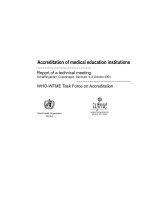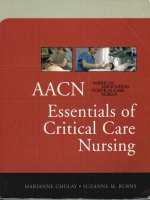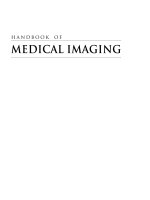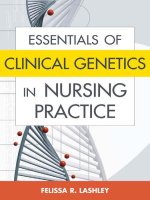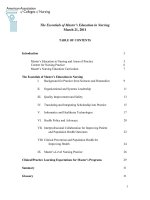Essentials of medical parasitology
Bạn đang xem bản rút gọn của tài liệu. Xem và tải ngay bản đầy đủ của tài liệu tại đây (35.23 MB, 358 trang )
Essentials of
MEDICAL PARASITOLOGY
Essentials of
MEDICAL PARASITOLOGY
Apurba Sankar Sastry MD (JIPMER),DNB, MNAMS, PDCR
Assistant Professor
Department of Microbiology
Jawaharlal Institute of Postgraduate Medical Education & Research (JIPMER)
Pondicherry, India
Sandhya Bhat K MD, DNB, MNAMS, PDCR
Assistant Professor
Department of Microbiology
Pondicherry Institute of Medical Sciences (PIMS)
(A Unit of Madras Medical Mission)
Pondicherry, India
Foreword
Reba Kanungo
JAYPEE BROTHERS MEDICAL PUBLISHERS (P) LTD
New Delhi • London • Philadelphia • Panama
Jaypee Brothers Medical Publishers (P) Ltd
Headquarters
Jaypee Brothers Medical Publishers (P) Ltd
4838/24, Ansari Road, Daryaganj
New Delhi 110 002, India
Phone: +91-11-43574357
Fax: +91-11-43574314
Email:
Overseas Offices
J.P. Medical Ltd
83 Victoria Street, London
SW1H 0HW (UK)
Phone: +44-2031708910
Fax: +02-03-0086180
Email:
Jaypee-Highlights Medical Publishers Inc.
City of Knowledge, Bld. 237, Clayton
Panama City, Panama
Phone: +1 507-301-0496
Fax: +1 507-301-0499
Email:
Jaypee Medical Inc.
The Bourse
111 South Independence Mall East
Suite 835, Philadelphia, PA 19106, USA
Phone: +1 267-519-9789
Email:
Jaypee Brothers Medical Publishers (P) Ltd
17/1-B Babar Road, Block-B, Shaymali
Mohammadpur, Dhaka-1207
Bangladesh
Mobile: +08801912003485
Email:
Jaypee Brothers Medical Publishers (P) Ltd
Bhotahity, Kathmandu, Nepal
Phone: +977-9741283608
Email:
Website: www.jaypeebrothers.com
Website: www.jaypeedigital.com
© 2014, Jaypee Brothers Medical Publishers
The views and opinions expressed in this book are solely those of the original contributor(s)/author(s) and do not
necessarily represent those of editor(s) of the book.
All rights reserved. No part of this publication may be reproduced, stored or transmitted in any form or by any means,
electronic, mechanical, photocopying, recording or otherwise, without the prior permission in writing of the publishers.
All brand names and product names used in this book are trade names, service marks, trademarks or registered
trademarks of their respective owners. The publisher is not associated with any product or vendor mentioned in this book.
Medical knowledge and practice change constantly. This book is designed to provide accurate, authoritative information about
the subject matter in question. However, readers are advised to check the most current information available on procedures
included and check information from the manufacturer of each product to be administered, to verify the recommended
dose, formula, method and duration of administration, adverse effects and contraindications. It is the responsibility of the
practitioner to take all appropriate safety precautions. Neither the publisher nor the author(s)/editor(s) assume any liability
for any injury and/or damage to persons or property arising from or related to use of material in this book.
This book is sold on the understanding that the publisher is not engaged in providing professional medical services. If
such advice or services are required, the services of a competent medical professional should be sought.
Every effort has been made where necessary to contact holders of copyright to obtain permission to reproduce copyright
material. If any have been inadvertently overlooked, the publisher will be pleased to make the necessary arrangements
at the first opportunity.
Inquiries for bulk sales may be solicited at:
Essentials of Medical Parasitology
First Edition: 2014
ISBN: 978-93-5152-329-1
Printed at
Dedicated to
Our Beloved Parents, Family members
And above all the Almighty
“Life is the most difficult exam. Many fail because they tend to copy others
Not realizing that everyone has different question paper.”
Foreword
Our understanding of human diseases has been greatly benefited from the
rapid strides made in Medical Science. It is necessary to compile and document
these advances in textbooks for students who are pursuing medical and allied
courses. To add the existing resources of information on parasitic diseases,
Dr Apurba Sankar Sastry and Dr Sandhya Bhat k have conceptualized and
compiled this book entitled “Essentials of Medical Parasitology.” They have
addressed details of information required by a medical graduate to help him to
understand the subject and also keep abreast with latest developments in the
field of Medical Parasitology.
The book is divided into four sections that deal with Protozoa, Helminths,
etc that are of importance to human health and disease. Each section deals
with general concepts including commonly used terminologies and their
definitions which will help the reader to understand their implications when used later in the text. Every
chapter is designed in a thematic manner with a brief classification including classification based on the
habitat and site of infection. This is followed by description of the parasite’s morphology, epidemiology of
the disease and pathogenesis. Clinical spectrum of the disease is described with emphasis on pathology,
clinical features and stages of the parasite that are encountered in the human host. Life cycle outside
the human host and natural habitat in the environment or animals have been explained in detail in the
respective chapter.
Thee chapters are interspersed with relevant illustrations. Photomicrographs are clear emphasizing
the natural appearance in clinical material. Diagrams and flow charts of life cycles are clear and well
represented. The authors have collected original images from several sources to highlight the actual
microscopic images seen in the laboratory and in situ appearance in tissue sections.
Laboratory methods to detect the agents in relevant clinical material have been described in detail
in easy procedural steps. Several additional and supportive tests to diagnose the infections have been
mentioned in each chapter. Recent techniques and current tests including specific antigen and antibody
detection methods used in the laboratories have been described. This will help a fresh graduate in
clinical practice to use the information in day to day practice.
An interesting feature in each chapter is the preventive aspect of commonly encountered parasitic
diseases, with a note on vaccination. An additional feature of the book is an up-to-date information on
the parasitic diseases of public health importance in India including national programs for prevention
and control. Opportunistic parasitic infections in the immunocompromised patients including HIV
infected individuals have been described along with the specific indicators for detection.
Each chapter ends with a set of self assessment questions which will help a student to prepare for the
examination. This is a well planned and executed parasitology book which both MBBS undergraduate
students and postgraduates pursuing a course in Medical Microbiology will find useful. I congratulate
the authors for bringing out this comprehensive textbook on parasitology.
Reba Kanungo MD PhD
Dean Research and Professor and Head
Department of Clinical Microbiology
Pondicherry Institute of Medical Sciences
Puducherry
Past President, Indian Association of Medical Microbiologists
Former Editor-in-Chief, Indian Journal of Medical Microbiology
E-mail:
Preface
Medical parasitology is an interdisciplinary science that deals with the study of animal parasites which
infect and produce diseases in human beings. This book is designed specifically for undergraduate
medical and paramedical students as well as for postgraduate students.
Medical students always complain that there is no standard Indian textbook on parasitology at present
which can fulfil the need of the examination and for the management of the parasitic diseases.
Currently available Indian medical parasitology books are neither updated with recent advances nor
presented in a student‐friendly manner. Day-to-day developments in the field of parasitology and the
unavailability of a standard textbook fulfilling the needs and expectation of the students, motivated us
to write a book in an updated format with recent epidemiological data, laboratory techniques, treatment
strategies, etc in such a way that student can grasp it easily.
The whole content of the book has been arranged in a bulleted format and use of sub heads has
increased the readability. Entire book is divided into four sections—General introduction, Protozoology,
Helminthology and Miscellaneous. At the end, six appendices have been incorporated which will be of
immense use and initiate interest among the students. Expected questions including MCQs have been
added at the end of each chapter which will help to reinforce and understand the related topic in a
better way. Life cycles are drawn in lucid and easy-to-grasp manner, exactly according to the text. Real
microscopic images of parasites and specimens from various sources are being incorporated to correlate
their impressions with the related parasitic diseases. Laboratory diagnosis and treatment boxes are
introduced as a different entity for a quick review for students as well as for physicians.
Our endeavor will be successful, if the book is found to be useful for student as well as for the faculty.
Apurba Sankar Sastry
()
Sandhya Bhat K
()
Acknowledgments
ACKNOWLEDGEMENT FOR CONTRIBUTING THE FIGURES
At the very outset, we express our deepest sense of gratitude to all who have given consent to provide their
valuable photographs.
SINCERE ACKNOWLEDGEMENTS FOR HELPING IN MANUSCRIPT PREPARATION:
This book would have never seen the light without the immeasurable generosity of the following people
who guided, supported and stood by us throughout the journey of manuscript preparation.
• Dr Anand Janagond, Associate Professor, Dept. of Microbiology, Velammal Medical College, Madurai,
for his valuable suggestions during the manuscript preparation.
• Dr Sharadadevi Mannur, Associate Professor, Dept. of Microbiology, Sri Siddhartha Medical College,
Tumkur, karnataka for helping in the correction of the manuscript.
• Dr Rudresh Shoorashetty Manohar, Assistant Professor, Dept. of Microbiology, ESIC Medical College,
Bangalore in helping the preparation of Trematode chapter manuscript.
• Dr Pranay Panigrahi, Post graduate student (Surgery), MkCG Medical college, Berhampur, Orissa, for
helping in the correction of the manuscript
• Dr S. Sujatha, Professor, Dept. of Microbiology, JIPMER for her valuable suggestions during the initial
manuscript preparation.
• Dr Rahul Dhodapkar, Associate Professor, Dept. of Microbiology, JIPMER for his valuable suggestions
during the initial manuscript preparation.
• Mr kaviyarasan and Ms Rajeswari, Meenakshi Medical College, Chennai for their help in drawing few
schematic diagrams.
SPECIAL ACKNOWLEDGEMENTS TO OUR PUBLISHERS:
(Jaypee Brothers Medical Publishers (P) Ltd)
• Shri Jitendar P Vij (Group Chairman)
• Mr Ankit Vij (Group President)
• Mr Bhupesh Arora (Associate Director Marketing and GM Publishing)
• Dr Sakshi Arora (Chief Development Editor)
• Mrs Nitasha Arora and Dr Mrinalini Bakshi (Editors)
• Mrs Seema Dogra (Senior Designer)
• Mr Phool kumar, Mr Sachin Dhawan, Mr Shekhar Bhatt and Mr Neeraj Choudhary (Operators and
Designer)
HEARTY ACKNOWLEDGEMENTS TO DEPARTMENT STAFFS AND RELATIVES FOR THEIR BLESSING
AND SUPPORT
• Dr. Reba kanungo, Dean Research, Professor and Head, Department of Clinical Microbiology,
Pondicherry Institute of Medical Sciences (PIMS) for giving the foreword.
• Dr TS Ravikumar, Director, JIPMER
• Dr John Abraham, Director-Principal, Pondicherry Institute of Medical Sciences (PIMS)
• JIPMER, Deparment of Microbiology Faculty:
hh Dr S Badrinath, Project consultant, Ex Professor and Head
hh Dr SC Parija, Dean Research, Ex Professor and Head
xii
Essentials of Medical Parasitology
Dr BN Harish, Professor and Head
Dr S Sujatha, Professor
hh Dr Jharna Mandal, Associate Professor
hh Dr Rakesh Singh, Associate Professor
hh Dr Rahul Dhodapkar, Associate Professor
hh Dr Rakhi Biswas, Assistant Professor
hh Dr Noyal M Joseph,Assistant Professor
hh Dr Hitender Gautam, Assistant Professor
• Pondicherry Institute of Medical Sciences (PIMS), Deparment of Microbiology Faculty:
hh Dr Reba kanungo, Dean Research and Professor & Head
hh Dr Shashikala, Professor
hh Dr Sheela Devi, Professor
hh Dr Esther Paul, Associate Professor
hh Dr Johny Asir, Assistant Professor
hh Dr P Vivian Joseph, Assistant Professor
hh Dr Sujitha V, Assistant Professor
hh Dr Anandhalakshmi, Assistant Professor
hh Ms SM Shanthi, Tutor
hh Mrs Desdemona Rasitha, Tutor
• JIPMER, Department of Microbiology: Residents, PhD scholars, technicians and non teaching staff.
• Pondicherry Institute of Medical Sciences (PIMS), Department of Clinical Microbiology — PG
students, technicians and non teaching staff
• Meenakshi Medical College, Chennai, Department of Microbiology staffs — Dr Amshavathani
(Professor and HOD), Dr Senthamarai (Associate Professor), Dr Sivasankari (Associate Professor),
Dr kumudavathi (Tutor) and Dr Anitha (Assistant Professor)
• ESIC Medical College and PGIMSR, Chennai, Department of Microbiology staffs and residents
• Sri Siddhartha Medical College, Tumkur, karnataka, Department of Microbiology staffshh Dr ER Nagaraj, Professor and Head
hh Dr Sharadadevi Mannur, Associate Professor
hh Dr Renushree, Associate Professor
• Our friends: Dr Godfred, Mr Sisir, Dr Sadia, Dr Srinivas, Dr Chaya, Dr Manisa, Dr Ira
• All maternal and paternal relatives and cousins
Last, but not the least, we want to thank the Almighty for bestowing all his blessings.
hh
hh
Contents
Section 1: Introducion
Chapter 1: General Introduction To Parasitology
•
•
•
•
•
Taxonomy of parasites 3
Parasite 3
Host 4
Host-parasite relationship 4
Transmission of parasites 5
•
•
•
•
•
3–15
Life cycle of the parasites 6
Pathogenesis of parasitic diseases 6
Immunology of parasitic diseases 8
Laboratory diagnosis of parasitic diseases 9
Treatment of parasitic diseases 10
Section 2: Protozoology
Chapter 2: Introduction to Protozoa
• General features of protozoa 19
19–23
• Classification of protozoa 19
Chapter 3: Amoeba
• Classification of amoeba 24
• Intestinal amoeba 24
Pathogenic intestinal amoeba 24
Entamoeba histolytica 24
hh Nonpathogenic intestinal amoeba 35
−− Entamoeba dispar 35
−− Entamoeba moshkovskii 36
−− Entamoeba coli 36
−− Entamoeba hartmanni 38
hh
−−
24–48
Entamoeba gingivalis 38
Entamoeba polecki 39
−− Endolimax nana 39
−− Iodamoeba butschlii 39
• Free-living (opportunistic) amoeba 40
hh Naegleria fowleri 40
hh Acanthamoeba species 43
hh Balamuthia mandrillaris 46
hh Sappinia diploidea 47
−−
−−
Chapter 4: Flagellates—I (Intestinal and Genital)
•
•
•
•
•
Classification of flagellates 49
Giardia lamblia 50
Trichomonas vaginalis 55
Pentatrichomonas hominis 58
Trichomonas tenax 58
•
•
•
•
Chilomastix mesnili 58
Enteromonas hominis 59
Retortamonas intestinalis 60
Dientamoeba fragilis 60
49–62
xiv
Essentials of Medical Parasitology
Chapter 5: Flagellates—II (Hemoflagellates)
• Introduction 63
• Morphology of hemofl agellates 63
• Leishmania 64
Old World Leishmaniasis 64
Leishmania donovani 64
−− Leishmania tropica complex 74
hh New World Leishmaniasis 76
hh
−−
Leishmania mexicana complex 77
Leishmania viannia braziliensis
complex 77
−− Leishmania leishmania chagasi 78
• Trypanosoma 79
• Trypanosoma cruzi 79
• Trypanosoma brucei complex 85
−−
−−
Chapter 6: Sporozoa—I (Malaria and Babesiosis)
• Classification 90
• Malaria parasite 90
118–139
• Cyclospora cayetanensis 131
• Isospora belli 133
• Sarcocystis species 135
Chapter 8: Miscellaneus Protozoa
• Microsporidium species 140
• Balantidium coli 146
90–117
• Babesia 114
Chapter 7: Sporozoa—II (Opportunistic Coccidian Parasites)
• Introduction 118
• Toxoplasma gondii 118
• Cryptosporidium parvum 126
63–89
140–150
• Blastocystis hominis 149
Section 3: Helminthology
Chapter 9: Introduction to Helminths
• General charactristics 153
• Morphology 154
153–155
• Life cycle 155
Chapter 10: Cestodes
• General characteristics of cestodes 156
Classification of cestodes 156
hh Morphology of cestodes 157
• Pseudophyllidean cestodes 160
hh Diphyllobothrium species 160
hh Spirometra species 163
hh
156–189
• Cyclophyllidean cestodes 165
hh
hh
hh
hh
Taenia species 165, 175
Echinococcus species 176
Hymenolepis nana 184, 186
Dipylidium caninum 187
Contents
Chapter 11: Trematodes or Flukes
190–219
• Classification of trematodes 190
• General characteristics of trematodes 191
• Blood flukes 193
hh
hh
hh
Schistosoma species 194, 201, 202
• Liver fluke 202
hh Fasciola species 202, 206
hh Clonorchis species 206
hh Opisthorchis species 208, 210
• Intestinal fluke 210
hh
hh
hh
hh
hh
hh
Fasciolopsis species 210
Gastrodiscoides species 213
Watsonius species 213
Heterophyes species 214
Metagonimus species 214
Echinostoma species 214
Lung fluke 215
Paragonimus species 215
Chapter 12: Nematodes—I (Intestinal Nematodes)
•
•
•
•
General properties of nematodes 220
Classification 220
General description 221
Large intestinal nematodes 224
hh Trichuris trichiura 224
hh
Enterobius vermicularis 227
• Small intestinal nematodes 230
hh
hh
hh
Hookworm 230
Strongyloides species 237, 242
Ascaris species 242, 246
Chapter 13: Nematodes—II Nematodes of Lower Animals
that Rarely infect Man
•
•
•
•
•
•
•
•
Classification 248
Larva migrans 248
Toxocariasis 250
Angiostrongylus species 252
Baylisascaris procyonis 253
Lagochilascaris minor 253
Anisakiasis 253
Gnathostoma species 254
•
•
•
•
•
•
•
Wuchereria bancrofti 265
Brugia speices 274, 275
• Other filarial nematodes 276
hh Loa loa 276
hh
hh
248–261
Capillaria species 255, 256, 257
Trichostrongylus species 257
Dioctophyme renale 258
Oesophagostomum species 259
Ternidens deminutus 259
Mammomonogamus laryngeus 260
Thelazia species 260
Chapter 14: Nematodes—III (Somatic Nematodes)
• Classification 262
• Filarial nematode 262
• Lymphatic filarial nematodes 265
220–247
262–289
Onchocerca volvulus 277
Mansonella species 280, 281
hh Dirofilaria species 282
• Other Somatic nematodes 282
hh Dracunculus medinensis 282
hh Trichinella spiralis 285
hh
hh
xv
xvi
Essentials of Medical Parasitology
Section 4: Miscellaneous
Chapter 15: Laboratory Diagnosis of Parasitic Diseases
•
•
•
•
•
Introduction 293
Morphological identification techniques 293
Culture techniques in parasitology 303
Immunodiagnostic methods 307
Molecular methods 309
•
•
•
•
Intradermal skin tests 310
Xenodiagnostic techniques 311
Animal inoculation methods 311
Imaging techniques 311
Chapter 16: Medical Entomology
• Medical entomology 314
• Vector 314
• Class insecta 314
293–313
314–321
• Class arachnida 319
• Class crustacea 320
• Control of Arthropods 320
Appendices325–333
•
•
•
Appendix I
Clinical syndromes in parasitology 325
Appendix II
Common tropical parasitic diseases 327
Appendix III
Romanowsky stains, composition and staining
procedures 327
• Appendix IV
Laboratory-acquired parasitic infections 329
• Appendix V
Biomedical waste management in
parasitology 330
• Appendix VI
Morphological forms of parasites seen in the
fecal sample 331
Index335–341
Section
1
Introduction
Chapter 1
Chapter-01.indd 1
General Introduction: Parasitology
5/17/2014 5:48:03 PM
Chapter-01.indd 2
5/17/2014 5:48:03 PM
1
General Introduction:
Parasitology
Chapter Outline
•
•
•
•
•
•
Taxonomy of parasites
Parasite
Host
Host-parasite relationship
Transmission of parasites
Life cycle of the parasites
Medical Parasitology deals with the study of
animal parasites, which infect and produce
diseases in human beings.
TAXONOMY OF PARASITES
According to the binomial nomenclature as
suggested by Linnaeus, each parasite has two
names: a genus and a species name.
These names are either derived from:
names of their discoverers, Greek or Latin
words of the geographical area where they
are found, habitat of the parasite, or hosts
in which parasites are found and its size and
shape.
All parasites are classified under the
following taxonomic units—the kingdom,
subkingdom, phylum, subphylum, super
class, class, subclass, order, suborder, super
family, family, genus and species.
The generic name of the parasite always
begins with an initial capital letter and
Chapter-01.indd 3
•
•
•
•
•
Pathogenesis of parasitic diseases
Immunology of parasitic diseases
Laboratory diagnosis of parasitic diseases
Treatment of parasitic diseases
Expected questions
species name with an initial small letter,
e.g., Entamoeba histolytica.
PARASITE
Parasite is a living organism, which lives in
or upon another organism (host) and derives
nutrients directly from it, without giving any
benefit to the host.
Protozoa and helminths (animal parasites)
are studied in Medical Parasitology.
Parasites may be classified as:
z
z
Ectoparasite: They inhabit the surface of
the body of the host without penetrating
into the tissues. They are important vectors
transmitting the pathogenic microbes. The
infection by these parasites is called as
infestation, e.g ., fleas or ticks
Endoparasite : They live within the body of
the host (e.g., Leishmania). Invasion by the
endoparasite is called as infection.
5/17/2014 5:48:04 PM
4
Section 1
Introduction
The endoparasites are of following types:
Obligate parasite: They cannot exist
without a parasitic life in the host (e.g.,
Plasmodium species)
z Facultative parasite: They can live a
parasitic life or free-living life, when the
opportunity arises (e.g., Acanthamoeba)
z Accidental parasite: They infect an unusual
host (e.g., Echinococcus granulosus infect
humans accidentally)
z Aberrant parasite or wandering parasite:
They infect a host where they cannot live or
develop further (e.g., Toxocara in humans).
source of infection to other susceptible
hosts. (e.g., dog is the reservoir host for
cystic echinococcosis)
Paratenic host: It is the host, in which
the parasite lives but it cannot develop
further and not essential for its life cycle is
known as paratenic host (e.g., fresh water
prawn for Angiostrongylus cantonensis,
big suitable fish for plerocercoid larva of
Diphyllobothrium latum and freshwater
fishes for Gnathostoma spinigerum). It
functions as a transport or carrier host
Amplifier host: It is the host, in which the
parasite lives and multiplies exponentially.
z
z
z
HOST
Host is defined as an organism, which harbors
the parasite and provides nourishment and
shelter.
Hosts may be of the following types:
z Definitive host: The host in which the
adult parasites replicate sexually (e.g.,
anopheles species), is called as definitive
host. The definitive hosts may be human or
nonhuman living things
z Intermediate host: The host in which the
parasite undergoes asexual multiplication
is called as intermediate host. (e.g., in
malaria parasite life cycle, humans are the
intermediate hosts)
h Intermediate hosts are essential for the
completion of the life cycle for some
parasites
h Some parasites require two intermediate hosts to complete their different larval stages. These are known as
the first and second intermediate hosts
respectively (e.g., Amphibian snails are
the first intermediate host and aquatic
plants are the second intermediate host
for Fasciola hepatica)
Hosts can also be :
z Reservoir host: It is a host, which harbours
the parasites and serves as an important
Chapter-01.indd 4
HOST-PARASITE RELATIONSHIP
The relationship between the parasite and the
host, may be divided into the following types:
z
z
z
Symbiosis: It is the close association
between the host and the parasite. Both are
interdependent upon each other that one
cannot live without the help of the other.
None of them suffer any harm from each
other
Commensalism: It is an association in which
the parasite only derives the benefit without
causing any injury to the host. A commensal
is capable of living an independent life
Parasitism: It is an association in which the
parasite derives benefit from the host and
always causes some injury to the host. The
host gets no benefit in return.
Disease: The disease is the clinical
manifestation of the infection, which shows
the active presence, and replication of the
parasite causing damage to the host. It may
be mild, severe and fulminant and in some
cases may even cause death of the host.
Carrier: The person who is infected with
the parasite without any clinical or sub
clinical disease is referred to as a carrier. He
can transmit the parasites to others.
5/17/2014 5:48:04 PM
Chapter 1 General Introduction: Parasitology
TRANSMISSION OF PARASITES
zz
It depends upon:
Source or reservoir of infection
zz Mode of transmission.
zz
Sources of Infection
zz
zz
zz
Man: Man is the source or reservoir for
a majority of parasitic infections (e.g.,
amoebiasis, enterobiasis, etc.) The infection
transmitted from one infected man to
another man is called as anthroponoses
Animal: The infection which is transmitted
from infected animals to humans is called as
zoonoses. The infection can be transmitted
to humans either directly or indirectly via
vectors. (e.g., cystic echinococcosis from
dogs and toxoplasmosis from cats)
Vectors: Vector is an agent, usually an
arthropod that transmits the infection
from one infected human being to another.
Vector can be biological or mechanical. An
infected blood sucking insect can transmit
the parasite directly into the blood during
its blood meal.
Note: Vectors have been dealt in detail in Medical
Entomology (Chapter 16).
zz
zz
zz
Contaminated soil and water: Soil polluted
with human excreta containing eggs of the
parasites can act as an important source of
infection, e.g., hookworm, Ascaris species,
Strongyloides species and Trichuris species.
Water contaminated with human excreta
containing cysts of E. histolytica or Giardia
lamblia, can act as source of infection
Raw or under cooked meat: Raw beef
containing the larvae of Cysticercus bovis and
pork containing Cysticercus cellulosae are
some of the examples where undercooked
meat acts as source of infection
Other sources of infection: Fish, crab or
aquatic plants, etc.
Modes of Transmission
The infective stages of various parasites may
be transmitted from one host to another in
the following ways:
Chapter-01.indd 5
zz
zz
zz
zz
zz
zz
5
Oral or feco-oral route: It is the most
common mode of transmission of the
parasites. Infection is transmitted orally
by ingestion of food, water or vegetables
contaminated with feces containing the
infective stages of the parasite. (e.g., cysts of E.
histolytica, and ova of Ascaris lumbricoides)
Penetration of the skin and mucous
membr anes: Infection is transmitted
by the penetration of the larval forms of
the parasite through unbroken skin (e.g.,
filariform larva of Strongyloides stercoralis
and hookworm can penetrate through
the skin of an individual walking barefooted over fecally contaminated soil), or by
introduction of the parasites through bloodsucking insect vectors. (e.g., Plasmodium
species, Leishmania species and Wuchereria
bancrofti)
Sexual contact: Trichomonas vaginalis
is the most frequent parasite to be
transmitted by sexual contact. However,
Entamoeba, Giardia and Enterobius are also
transmitted rarely by sexual contact among
homosexuals
Bite of vectors: Many parasitic diseases
are transmitted by insect bite (Table 16.2
in Chapter 16) such as: malaria (female
anopheles mosquito), filariasis (Culex),
leishmaniasis (sandfly), Chagas’ disease
(reduviid bug) and African sleeping sickness
(tsetse fly)
Vertical transmission: Mother to fetus
transmission is important for few parasitic
infections like Toxoplasma g ondii,
Plasmodium spp. and Trypanosoma cruzi.
Blood transfusion: Certain parasites
l i k e P l a s m o d i u m s p e c i e s, B ab e s i a
species, Toxoplasma species, Leishmania
species and Trypanosoma species can be
transmitted through transfusion of blood
or blood products
Autoinfection: Few intestinal parasites
may be transmitted to the same person
by contaminated hand (external auto
infection) or by reverse peristalsis (inter
5/17/2014 5:48:04 PM
6
Section 1
Introduction
nal autoinfection). It is observed in Cryptosporidium parvum, Taenia solium, Enterobius
vermicularis, Strongyloides stercoralis and
Hymenolepis nana.
LIFE CYCLE OF THE PARASITES
The life cycle of the parasite may be direct
(simple) or indirect (complex).
z Direct/simple life cycle: When a parasite
requires only one host to complete its
development, it is referred as direct/simple
life cycle (Table 1.1)
z Indirect/complex life cycle: When a
parasite requires two hosts (one definitive
host and another intermediate host) to
complete its development, it is referred
as indirect/complex life cycle (Table 1.2).
Some of the helminths require three hosts
(one definitive host and two intermediate
hosts) (Table 1.3).
Table 1.1: Direct/simple life cycle—parasites that
need only one host (man)
Protozoa
Helminths
•
•
•
•
•
•
•
•
Cestodes
• Hymenolepis nana
Entamoeba histolytica
Giardia lamblia
Trichomonas vaginalis
Balantidium coli
Cryptosporidium parvum
Cyclospora cayetanensis
Isospora belli
Microsporidia
Nematodes
• Ascaris lumbricoides
• Hookworm
• Enterobius spp.
• Trichuris trichiura
• Strongyloides spp.
PATHOGENESIS OF PARASITIC
DISEASES
The parasites can cause damage to humans in
various ways.
z Mechanical trauma:
h Eggs: Trematode eggs being large
in size, can be deposited inside the
Table 1.2: Indirect/complex life cycle: parasites requiring one definitive host and one intermediate host
Man acts as definitive host
Parasites
Leishmania spp.
Definitive host (man)
Man
Intermediate host
Sandfly
Trypanosoma cruzi
Man
Reduviid bugs
Trypanosoma brucei
Man
Tsetse fly
Taenia solium (intestinal taeniasis)
Man
Pig
Taenia saginata
Man
Cattle
Hymenolepis diminuta
Man
Rat flea
Schistosoma spp.
Man
Snail
Trichinella spiralis
Man
Pig
Filarial worms
Man
Mosquito (culex, aedes, anopheles) and
flies (blackflies and deerflies)
Dracunculus medinensis
Man
Cyclops
Parasites
Definitive host
Intermediate host
Plasmodium spp.
Female anopheles mosquito
Man
Babesia spp.
Tick
Man
Sarcocystis lindemanni
Cat and dog
Man
Toxoplasma gondii
Cat
Man
Echinococcus granulosus
Dog
Man
Taenia solium (Cysticercosis)
Man
Man
Man acts as intermediate host
Chapter-01.indd 6
5/17/2014 5:48:05 PM
Chapter 1
General Introduction: Parasitology
7
Table 1.3: Indirect/complex life cycle: parasites requiring one definitive host and two intermediate hosts
Parasites
Definitive host
First intermediate host
Second intermediate
host
Diphyllobothrium spp.
Man
Cyclops
Fish
Fasciola hepatica
Man
Snail
Aquatic plant
Fasciolopsis buski
Man
Snail
Aquatic plant
Paragonimus spp.
Man
Snail
Crab and fish
Clonorchis spp.
Man
Snail
Fish
Opisthorchis spp.
Man
Snail
Fish
Gnathostoma spinigerum
Cat, dog and man
Cyclops
Fish
z
z
z
intestinal mucosa (Schistosoma mansoni), bladder (Schistosoma haematobium), lungs (Paragonimus), liver
(Fasciola hepatica) and can cause
mechanical irritation
h Larvae: Migration of several helminthic
larvae (hookworms, Strongyloides or
Ascaris) in the lungs produce traumatic
damage of the pulmonary capillaries
leading to pneumonitis
h Adult worms: Adult worms of hookworm, Strongyloides, Ascaris or Taenia
get adhere to the intestinal wall and
cause mechanical trauma
Space occupying lesions: Certain parasites
produce characteristic cystic lesion that may
compress the surrounding tissues or organs,
e.g., hydatid cysts and neurocysticercosis
Inflammatory reactions: Most of the
parasites induce cellular proliferation and
infiltration at the site of their multiplication,
e.g., E. histolytica provokes inflammation of
the large intestine leading to the formation
of amoebic granuloma. Adult worm of
W. bancrofti causes mechanical blockage
and chronic inflammation of the lymphatics
and lymph vessels. Trematode eggs can
induce inflammatory changes (granuloma
formation) surrounding the area of egg
deposition
Enzyme production and lytic necrosis:
Obligate intracellular parasites of man
Chapter-01.indd 7
z
z
z
z
(Plasmodium, Leishmania and Trypanosoma), produce several enzymes, which
cause digestion and necrosis of host cells.
E. histolytica produces various enzymes like
cysteine proteinases, hydrolytic enzymes
and amoebic pore forming protein that lead
to destruction of the target tissue
Toxins: Some of the parasites produce
toxins, which may be responsible for pathogenesis of the disease, e.g., E. histolytica.
However, in contrast to bacterial toxin,
parasitic toxins have minimal role in
pathogenesis
Allergic manifestations: Many metabolic
and excretory products of the parasites get
absorbed in the circulation and produce
a variety of allergic manifestations in the
sensitized hosts
Examples include schistosomes causing
cercarial dermatitis, rupture of hydatid
cyst producing anaphylactic reactions
and occult filariasis (tropical pulmonary
eosinophilia)
Neoplasia: Some of the parasitic infections
can contribute to the development of
neoplasia (e.g., S. haematobium causes
bladder carcinoma, Clonorchis and
Opisthorchis cause cholangiocarcinoma)
Secondary bacterial infections: Seen in
some helminthic diseases (schistosomiasis
and strongyloidiasis).
5/17/2014 5:48:05 PM
8
Section 1 Introduction
IMMUNOLOGY OF PARASITIC
DISEASES
The immune response against the parasitic
infections depends on two factors:
zz Host factors: Immune status, age, under
lying disease, nutritional status, genetic
constitution and various defense mechanisms
of the host
zz Parasitic factors: Size, route of entry,
frequency of infection, parasitic load and
various immune evasion mechanisms of
the parasites.
Broadly, the host immunity against the
parasitic diseases may be of two types:
1. Protective immune response
i. Innate immunity
ii. Adaptive/acquired immunity
2. Unwanted or harmful immune response
(hypersensitive reactions).
zz
zz
zz
Protective Immune Response
Both innate and acquired immunity play an
important role in protecting the hosts against
parasites. Some of the parasitic infections can
be eliminated completely by the host immune
responses (complete immunity) while few
are difficult to eliminate. In some infections,
the immune defense of the host is sufficient
to resist further infection but insufficient to
destroy the parasite. Immunity lasts till the
original infection remains active and prevents
further infection. This is called as infection
immunity or premunition or concomitant
immunity or incomplete immunity. This is
observed in malaria, schistosomiasis, trichi
nellosis, toxoplasmosis and Chagas’ disease.
(i) Innate Immunity
Components of innate immunity
zz
zz
zz
zz
Innate immunity is the resistance which an
individual possesses by birth, due to genetic
and constitutional make-up.
Factors influencing innate immunity
zz
Age of the host: Both the extremes of age
are more vulnerable to parasitic infections.
Chapter-01.indd 8
Certain diseases are common in children
like giardiasis and enterobiasis while
certain infections occur more commonly
in adults like hookworm infection.
Congenital infection occurs commonly with
Toxoplasma gondii; whereas newborns are
protected from falciparum malaria because
of high concentration of fetal hemoglobin
Sex: Certain diseases are more common in
males like amoebiasis where as females are
more vulnerable to develop anemia due to
hookworm infection
Nutritional status: Both humoral and
cellular mediated immunity are lowered
and neutrophil activity is reduced in
malnutrition
Genetic constitution of the individuals:
People with hemoglobin S (sickle cell
disease), fetal hemoglobin and thalassemia
hemoglobin are resistant to falciparum
malaria where as Duffy blood group
negative red blood cells (RBCs) are resistant
to vivax malaria.
zz
Anatomic barriers (skin and mucosa):
Skin is an important barrier for the
parasites that enter by cutaneous routes like
Schistosomes, hookworm and Strongyloides
Physiologic barriers: It includes tempera
ture, pH, and various soluble molecules
like lysozyme, interferon and complement.
Gastric acidity acts as a physiologic barrier
to Giardia and Dracunculus
Phagocytosis: Phagocytes like macrophages
and microphages (neutrophils, basophils
and eosinophils) act as first line of defense
against the parasites
Complements: They play an important
role for killing the extracellular parasites
by forming membrane attack complexes;
that leads to the formation of holes in the
parasite membrane
Natural killer cells: Natural killer cells
(NKs) are another important mediator of
innate immunity. They play a central role
in killing few of the helminthic parasites.
5/17/2014 5:48:05 PM


